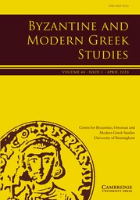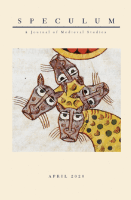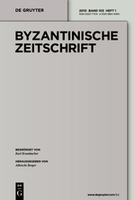
Zbornik Radova Vizantoloskog Instituta
metrics 2024
Fostering Global Discourse in Byzantine Research
Introduction
Zbornik Radova Vizantoloskog Instituta is a distinguished open-access journal published by the Institute of Byzantine Studies, Serbian Academy of Sciences and Arts, located in Belgrade, Serbia. Since its inception in 2003, this journal has served as a vital platform for the dissemination of scholarly research in the fields of Classics, History, Linguistics and Language, and Literature and Literary Theory. Although it currently holds a Q4 ranking in the 2023 category quartiles, its commitment to fostering academic discourse and research accessibility is unwavering. The journal features a diverse range of articles that explore the complexities and nuances of Byzantine studies and related disciplines, catering to a broad audience of researchers, professionals, and students dedicated to the humanities. With a focus on both historical context and contemporary perspectives, Zbornik Radova Vizantoloskog Instituta aims to contribute significant insights into the academic community while promoting scholarly interaction on a global scale.
Metrics 2024
 0.10
0.10 0.10
0.10 0.10
0.10 2
2Metrics History
Rank 2024
Scopus
JCI (Web Of Science)
Quartile History
Similar Journals

Deltion of the Christian Archaeological Society
Advancing Scholarship in the Intersection of Archaeology and TheologyDeltion of the Christian Archaeological Society (ISSN: 1105-5758, E-ISSN: 2241-2190), published by the Christian Archaeological Society in Athens, Greece, stands as a pivotal source of scholarly work within the realm of Christian archaeology. This journal is dedicated to disseminating high-quality research that promotes the understanding of Christian history, heritage, and archaeological practices. Though it operates under traditional access options, it provides a comprehensive platform for researchers and professionals alike, fostering dialogue and collaboration within the archaeological community. With a commitment to advancing knowledge, the Deltion aims to support both established scholars and emerging voices, reinforcing the significance of archaeology in interpreting religious narratives and cultural contexts. Researchers, students, and professionals interested in the intersections of archaeology, history, and theology will find this journal an invaluable resource in their scholarly pursuits.

Codex Aquilarensis
Illuminating Historical Insights through Artistic ExpressionCodex Aquilarensis is a distinguished academic journal published by FUNDACION SANTA MARIA REAL, CENTRO ESTUDIOS ROMANICO, specializing in History and Visual Arts and Performing Arts. With an ISSN of 0214-896X and an E-ISSN of 2386-6454, this journal has carved its niche within the scholarly community in Spain, encompassing a range of topics pertinent to its fields of study. Although it currently holds a Q4 category in both History and Visual Arts and Performing Arts as of 2023, it plays a critical role in disseminating important research and insights from 2015 to 2022, contributing to the academic dialogue around these disciplines. While access options are limited, the journal's commitment to enhancing understanding in the arts and humanities makes it a valuable resource for researchers, professionals, and students alike. Its ranking within Scopus further underscores its relevance, positioning it within the competitive landscape of arts and humanities research. Scholars and practitioners interested in historical and artistic studies are encouraged to engage with the content presented by Codex Aquilarensis as it continues to evolve and contribute to the intellectual heritage of the region.

Images
Illuminating Cultural Dynamics Through ImagesImages, published by BRILL, serves as a significant academic platform within the realms of Cultural Studies, History, Religious Studies, and the Visual Arts and Performing Arts. With its ISSN 1871-7993 and E-ISSN 1871-8000, this journal is committed to providing a scholarly forum that engages with the complexities of visual representations and their impact on cultural narratives. Though it currently holds a Q4 category ranking across various fields, indicating room for growth, its presence in Scopus rankings showcases its contribution to the arts and humanities, positioning it as a unique voice in interdisciplinary discourse. The journal aims to publish innovative research that fosters dialogue among scholars, practitioners, and students interested in the intersections of visual culture and societal dynamics. Despite its non-open access status, Images remains a vital resource for those seeking to understand the intricate fabric of cultural expressions from historical and contemporary perspectives, offering insights that resonate across academic and artistic landscapes.

Jahrbuch der Oesterreichischen Byzantinistik
Exploring the depths of Byzantine culture and history.Jahrbuch der Oesterreichischen Byzantinistik, published by the esteemed Österreichische Akademie der Wissenschaften, is a vital academic journal dedicated to advancing the study of Byzantine studies, history, and related fields. Situated in Austria, this journal serves as a critical platform for scholars and researchers, offering a rich collection of articles that reflect the diverse aspects of Byzantine culture, literature, and archaeological findings. Despite its recent categorization in the Q4 quartile in areas such as Archaeology, History, and Literary Theory, it commands impressive rankings within Scopus, particularly in Literature and Literary Theory at the 87th percentile, highlighting its growing impact in the arts and humanities. Researchers and professionals can access comprehensive studies that span from 2010 to 2018 and continue from 2020 to 2023, paving the way for interdisciplinary dialogue and exploration within the Byzantine field. As a continually evolving resource, the Jahrbuch is essential for those committed to deepening their understanding of this historically rich domain.

Konstantinove Listy-Constantines Letters
Exploring the intersections of thought and tradition.Konstantinove Listy - Constantines Letters is a premier academic journal published by the Constantine Philosopher University in Nitra, Slovakia. With a focus on the interdisciplinary exploration of historical, philosophical, and religious studies, this journal has established itself as a significant platform for scholarly discourse since its inception in 2015. The journal's impressive rankings—Q1 in History and Religious Studies, along with Q2 in Philosophy—demonstrate its commitment to high-quality research, concurrent with its strong performance in Scopus rankings, placing it in the 80th percentile for both Religious Studies and History disciplines. As an integral part of the academic landscape, Konstantinove Listy invites researchers, professionals, and students alike to contribute to its mission of advancing knowledge and understanding in these vital fields. While the journal operates under traditional publishing, it is recognized for its accessibility and contribution to fostering a vibrant scholarly community.

GREEK ROMAN AND BYZANTINE STUDIES
Championing Interdisciplinary Dialogues in Classical StudiesGREEK ROMAN AND BYZANTINE STUDIES, published by DUKE UNIVERSITY, is a leading journal dedicated to the exploration of ancient Greek and Roman civilizations as well as Byzantine history. With its ISSN 0017-3916 and E-ISSN 2159-3159, this prestigious journal has established itself as a vital platform for interdisciplinary research, boasting an impact factor worthy of recognition in the academic community. Since its transition to Open Access in 2004, GREEK ROMAN AND BYZANTINE STUDIES has enhanced the accessibility of scholarly work, fostering a collaborative environment for researchers, students, and professionals alike. Ranked in the Q2 category in Classics and History, and Q3 in Cultural Studies, this journal continues to be an essential resource for those investigating the philosophical, historical, and cultural dimensions of ancient societies. With a focus on innovative research and critical scholarship, GREEK ROMAN AND BYZANTINE STUDIES stands as a cornerstone for advancing knowledge and understanding within these influential fields.

BYZANTINE AND MODERN GREEK STUDIES
Bridging Byzantine Legacy with Modern IdentityBYZANTINE AND MODERN GREEK STUDIES, published by Cambridge University Press, is a premier journal dedicated to the exploration of Byzantine and modern Greek history, literature, culture, and linguistics. With an ISSN of 0307-0131 and an E-ISSN of 1749-625X, the journal has established itself as a significant contribution to the field since its inception in 1975, with converged publication years extending to 2024. It currently holds a commendable ranking in various categories, including Q2 in Cultural Studies and History, as well as Q1 in Literature and Literary Theory, reflecting its academic rigor and impact. Researchers and scholars can access a wealth of knowledge that highlights the intricate connections between Byzantine heritage and modern Greek identity, all while benefiting from the journal's high visibility in indexes such as Scopus, which ranks it favorably within the top percentiles of related fields. The journal's commitment to fostering interdisciplinary dialogue makes it an invaluable resource for those seeking to deepen their understanding and appreciation of Greece's historical and cultural narrative.

SPECULUM-A JOURNAL OF MEDIEVAL STUDIES
Exploring the Depths of Medieval InsightSPECULUM: A Journal of Medieval Studies, published by University of Chicago Press, stands as a premier academic platform within the field of medieval studies. With an impressive legacy dating back to its inception in 1926, this journal has attracted scholarly contributions that explore the rich tapestry of human experience during the medieval period, encompassing areas such as history, literature, philosophy, cultural studies, and the visual and performing arts. It boasts elite rankings—Q1 in History, Literature and Literary Theory, Religious Studies, and Visual Arts and Performing Arts, with a commendable Q2 in Cultural Studies and Philosophy—attesting to its impact and relevance in academia. Although it is not an open-access journal, the rigorous peer-review process and critical scholarship found within its pages provide invaluable insights for researchers, professionals, and students alike. With a substantial Scopus ranking, ID 0038-7134, and E-ISSN 2040-8072, SPECULUM continues to serve as an essential resource for advancing knowledge and understanding of the medieval world, encouraging interdisciplinary dialogue and scholarly interaction.

BYZANTINISCHE ZEITSCHRIFT
Exploring the Rich Tapestry of Byzantine HeritageBYZANTINISCHE ZEITSCHRIFT, an esteemed publication founded in 1892, is dedicated to advancing the study of Byzantine history, literature, and the arts. Published by WALTER DE GRUYTER GMBH in Germany, this journal holds a significant place in academic discourse, evidenced by its Q2 quartile ranking in both Literature and Literary Theory, and Visual Arts and Performing Arts, as well as its Q3 ranking in History according to the 2023 category quartiles. The journal is highly regarded for its contributions to scholarly discussions and features a diverse range of articles that appeal to researchers, professionals, and students alike. With its deep historical roots and a commitment to quality scholarship, BYZANTINISCHE ZEITSCHRIFT remains a crucial resource for anyone interested in the multifaceted dimensions of the Byzantine era, covering converged years from 1892 to 2024. Engage with this journal to explore the complex narratives and rich heritage of Byzantine culture and its lasting impact on contemporary scholarship.

Palaeobulgarica-Starobalgaristika
Showcasing Innovative Research on Bulgarian HeritagePalaeobulgarica-Starobalgaristika is a distinguished academic journal published by the Bulgarian Academy of Sciences, focusing on the rich history and cultural heritage of Bulgaria and the surrounding regions. With an ISSN of 0204-4021 and an E-ISSN of 2603-2899, this journal serves as an essential platform for researchers, historians, and scholars, providing a forum for the dissemination of innovative research and interdisciplinary studies. The journal has established its significance in the field by achieving an impressive Q3 ranking in History and boasting a Scopus rank of #702 out of 1760 in the Arts and Humanities category, placing it in the 60th percentile. Operating within the timeline of 2019 to 2024, it strives to explore various facets of Bulgarian history, cultural identity, and archaeological findings. While currently not an open-access journal, Palaeobulgarica-Starobalgaristika remains committed to enhancing the academic conversation within its field, making it an invaluable resource for those dedicated to understanding and preserving Bulgaria's historical narrative.